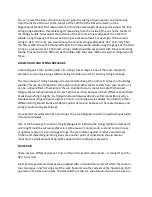
Vintage keys. For these, you'll want to pre-cut the strings to achieve the proper length and
desired amount of winds. Pull the sixth string (tautly, remember) to the fourth key and cut it.
Pull the fifth string to the third key and cut it. Pull the fourth string between the second and
first keys and cut it. Pull the third string nearly to the top of the headcap and cut it. Pull the
second string about a 1/2" (13 mm) past the headcap and cut it. Finally, pull the first string 1
1/2" (38 mm) past the top of the headcap and cut it. Insert into the center hole in the tuning
key, bend and crimp to a 90-degree angle, and wind neatly in a downward pattern, being
careful to prevent overlapping of the strings.
If your tuning keys have a screw on the end of the button, check the tightness of the screw. This
controls the tension of the gears inside the tuning keys. Do not over-tighten these screws. They
should be "finger-tight." This is very important, especially on locking tuners.
TREMOLO
Stratocaster guitars can have four distinctive types of bridges. The most well-known bridge is
the vintage-style "synchronized" tremolo. The other three are the American Series bridge,
which is a modern-day two-pivot bridge; the non-tremolo hardtail bridge; and a locking
tremolo, such as the American Deluxe or Floyd Rose® locking tremolos. If you have a non-
tremolo "hardtail" bridge, proceed to "Intonation (Roughing it out)."
First, remove the tremolo back cover. Check your tuning. For a vintage-style tremolo bridge, a
great way to enhance its performance is to pull the bridge back flush with the body using the
tremolo arm. Then loosen all six screws located at the front edge of the bridge plate, raising
them so that they all measure approximately 1/16" (1.6 mm) above the top of the bridge plate.
Then tighten the two outside screws back down until they're flush with the top of the bridge
plate. The bridge will now pivot on the outside screws, leaving the four inside screws in place
for bridge stability. For a two-pivot model such as the American Series bridge, use your tremolo
arm to pull the bridge back flush with the body and adjust the two pivot screws to the point
where the tremolo plate sits entirely flush at the body (not lifted at the front or back of the
plate).
Allowing the bridge to float freely (no tension on the tremolo arm) using the claw screws in the
tremolo cavity, adjust the bridge to your desired angle—Fender spec is a 1/8" (3.2 mm) gap at
rear of bridge. You'll need to retune periodically to get the right balance between the strings
and the springs. If you prefer a bridge flush to the body, adjust spring tension to equal string
tension, while the bridge rests on the body (you may want to put an extra 1/2 turn to each claw
screw to ensure that the bridge remains flush to the body during string bends). Caution: Do not
over-tighten the springs, as this can put unnecessary tension on the arm during tremolo use.
Finally, you may wish to apply a small dab of Chapstick® or Vaseline® at the pivot contact points
of the bridge for very smooth operation.
INTONATION (ROUGHING IT OUT)



























